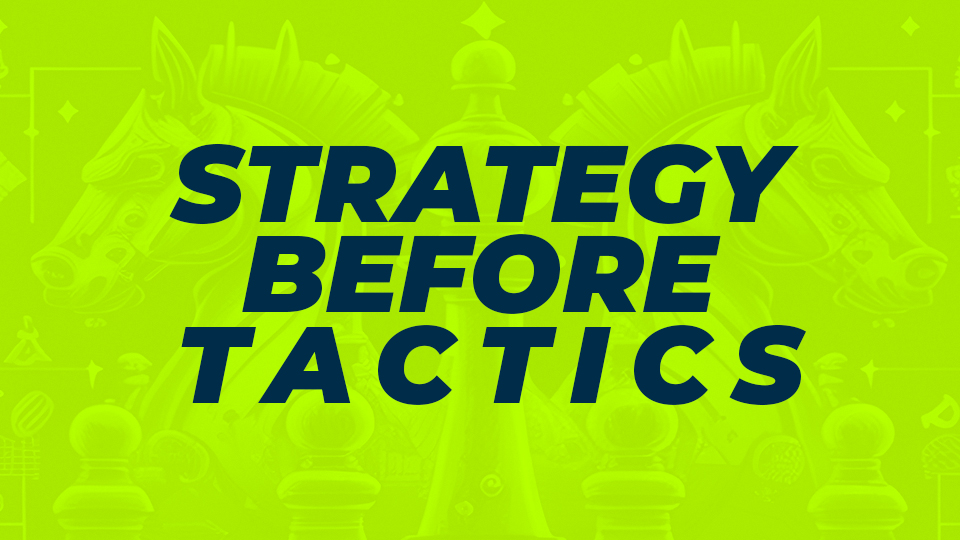
Breaking Free from the Tactics Trap: How to Maximize Your ROI by Prioritizing Strategy
When it comes to building and growing a brand, many businesses focus solely on tactics without considering the bigger picture. Whether it’s investing in a flashy new website, running constant social media promotions, or even rebranding entirely, these tactics can be costly and time-consuming. But without a clear strategy in place, they are often ineffective at driving real, measurable results.
Tactics
Let’s be clear, tactics are important. They are the tools that businesses use to execute their strategy and reach their goals. But tactics alone are not enough. They are like a hammer without a blueprint. A hammer is a useful tool, but it can’t build a house on its own. Similarly, tactics can’t build a successful brand on their own.
A brand strategy is the foundation of a business’s marketing efforts, providing direction and purpose for all the tactics that follow. It’s a long-term plan that defines the business’s unique value proposition, target audience, and competitive positioning, and it lays out a clear roadmap for how the business will achieve its goals. Without a strategy, businesses are left to try different tactics without any clear understanding of what they’re trying to achieve or why.

Strategy Comes First
The failure to develop a brand strategy is a common problem among businesses, especially small and medium-sized ones. They often lack the resources, knowledge, or time to develop a comprehensive strategy and instead focus on short-term, tactical solutions. However, this approach often leads to wasted resources and missed opportunities.
One of the biggest issues with not having a brand strategy is that businesses will often end up working on the wrong things. They may invest in tactics that don’t align with their goals, target the wrong audience, or fail to differentiate themselves from their competitors. This leads to poor return on investment (ROI) and a lack of long-term success.
Another problem with not having a brand strategy is that businesses will often miss out on opportunities for growth and expansion. Without a clear understanding of their target audience, businesses may not be able to identify new markets or customer segments that could be profitable. Additionally, without a clear competitive positioning, businesses may miss opportunities to differentiate themselves from the competition and capture market share.
Conclusion
To sum it up, brand strategy is essential for the long-term success of a business. It provides direction and purpose for all the tactics that follow and helps businesses achieve their goals. Without a clear strategy in place, businesses will often miss out on opportunities for growth and expansion, and will see poor return on investment (ROI). As a professional in the branding space, I urge business owners and marketers to invest the time and resources into developing a comprehensive brand strategy as an investment that will pay off in the medium and long term. If you apply this principle, you will see the benefits a lot sooner than you would expect.

3 Actions to Take for Building a Better Brand Strategy
Define your brand’s purpose and values: One of the most important things you can do to ensure that your tactics are aligned with your strategy is to clearly define your brand’s purpose and values. This will give you a clear roadmap to follow as you develop your tactics, and it will also help you ensure that your tactics are consistent with your overall brand message. To define your brand’s purpose and values, start by thinking about what your company stands for and what you want to achieve. Then, use this information to create a mission statement and a set of core values that will guide your tactics and strategy.
Conduct a thorough target audience analysis: Another key step in ensuring that your tactics are aligned with your strategy is to conduct a thorough target audience analysis. This will help you understand the needs, wants, and pain points of your target audience, which in turn will help you develop tactics that will effectively reach and engage them. To conduct a target audience analysis, start by defining your target audience in terms of demographics, psychographics, and behavior. Then, conduct research to gather information on their needs, wants, and pain points. Use this information to create buyer personas that will help guide your tactics.
Create a content calendar: Having a content calendar is essential for keeping your tactics aligned with your strategy. It will help you stay organized, plan ahead, and ensure that your content is consistent with your overall brand message. To create a content calendar, start by thinking about the different types of content that you want to create (e.g., blog posts, social media updates, email campaigns). Then, plan out when and where you will publish each piece of content. Make sure to include key dates, such as product launches, events, and holidays, that might impact your content strategy. Also, ensure that you have a system in place to track the performance of your content so that you can make necessary adjustments to your tactics.
Carry out these three exercises and you will be well on your way to ensuring that your tactics are aligned with your strategy, ultimately resulting in a higher return on investment for your brand. Remember, tactics without strategy is like trying to navigate a ship without a compass, you might get somewhere, but it’s unlikely to be the destination you were hoping for.




